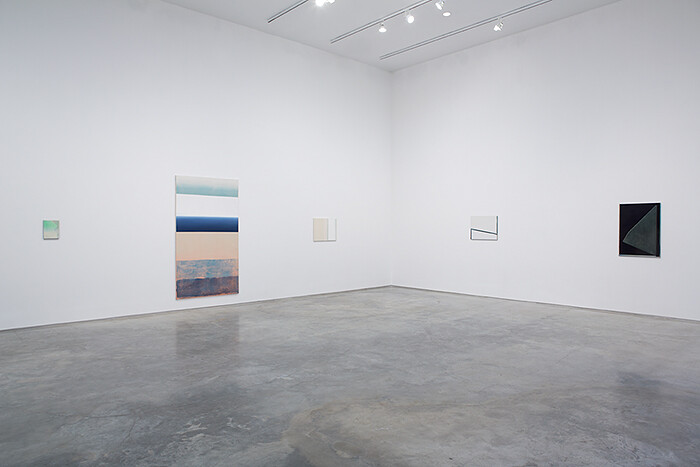Svenja Deininger’s current show at Marianne Boesky Gallery has a quietness to it, an air of minding its own business that can be initially disarming. From a distance, the geometric abstractions look as pristine and empty as the gallery’s walls: no external references, no critical provocations, nor expressive painterly effects—nothing, it seems, to hold the viewer’s attention at all. But with closer views, their formal goals become quite clear. Each painting plays various perceptual elements against each other, balancing opacity against transparency, turning surface into depth. Mass open spaces are girded with lines, and abstraction is held in captivity, on the brink of representational possibility.
“One Second Balance” is the Vienna-based painter’s first solo exhibition in New York, with fourteen untitled works all made in the previous year. The work is installed to form a possible trajectory through Deininger’s process, with one canvas often introducing a motif or element that is reprised in the next, in a limited palette of blacks, blues, greens, and pinks. The change of scale between the works only serves to further emphasize nuanced compositional details: as the viewer draws closer, what initially appeared to be virgin white matte space turns out have multiple layers and planes, and what looked to be a uniform dark stripe is made up of darker inky masses. Everything seems to happen around the edges, where crisp bands of textured paint hold shapes together and keep the eye in perpetual tension as it skims the surface.
One painting stands out for its recognizable subject matter: a detail of white canvas leaning against a dark wall, perhaps underlining the medium-specificity of her project. Deininger’s quest for formal balance may be well in keeping with the modernist boxing match between painterly surface and representational space, but novelty is not one of her goals: “I don’t have something new to say, rather at best something new to show,” she says in an interview. And her take is her own, a pared-down experiment in modernist flatness that stands on its own through the precarious complexity of her compositions, particularly when presented as a series. The experience of Deininger’s paintings is no less articulate for lacking a reference in the outside world—it may even be the outmoded, rarified quality of painting today that underscores the methodical nature of her investigation into surface effect.
One might say that Deininger’s paintings are abstract in the way that thinking is abstract, as a continuous process of sorting through memories of things that, if it is to succeed in solving the problem it has set itself, requires application and intuition in equal measure. The minimalist genealogy of her work may be less the humming screens of Agnes Martin than the methodical cubes of Sol LeWitt—but without the mathematical single-mindedness. A constellation of fellow travelers could be infinitely expanded upon, from Piet Mondrian to Mark Rothko, to the cool abstractions of R.H. Quaytman and—an inevitable reference—the small format paintings of Tomma Abts.
The final impression of Deininger’s paintings is less emptiness than a systematic and varied plenitude. Everything fits together with the grooved perfection of a jigsaw puzzle, albeit one that doesn’t hold together as a stable composition. Hard edges are counterbalanced by organic accident; photographic contrasts of light and dark hover over matte surfaces. In moving from one work to the next, the viewer’s gaze learns to follow the dynamic rhythms of each visual space. More than a logical investigation of a modest creative problem, the exhibition is also a demonstration of what it means to think through painting.






